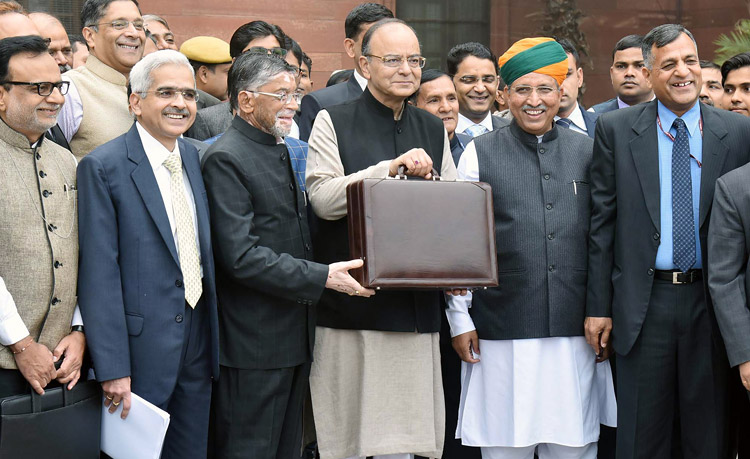INDIAN ARMED FORCES CHIEFS ON OUR RELENTLESS AND FOCUSED PUBLISHING EFFORTS

SP Guide Publications puts forth a well compiled articulation of issues, pursuits and accomplishments of the Indian Army, over the years

"Over the past 60 years, the growth of SP Guide Publications has mirrored the rising stature of Indian Navy. Its well-researched and informative magazines on Defence and Aerospace sector have served to shape an educated opinion of our military personnel, policy makers and the public alike. I wish SP's Publication team continued success, fair winds and following seas in all future endeavour!"

Since, its inception in 1964, SP Guide Publications has consistently demonstrated commitment to high-quality journalism in the aerospace and defence sectors, earning a well-deserved reputation as Asia's largest media house in this domain. I wish SP Guide Publications continued success in its pursuit of excellence.
Defence Budget 2017-2018
 |
By Lt. General P.C. Katoch (Retd) Former Director General of Information Systems, Indian Army |

The Union Minister for Finance and Corporate Affairs, Shri Arun Jaitley departs from North Block to Rashtrapati Bhavan and Parliament House, along with the Minister of State for Finance and Corporate Affairs, Shri Arjun Ram Meghwal, the Minister of State for Finance, Shri Santosh Kumar Gangwar and the senior officials to present the General Budget 2017-18, in New Delhi on February 01, 2017
Defence has been allocated 2,74,114 crore ($40.31 billion) for fiscal year 2017-2018. This does not include the pensions bill which itself is close to 85,000 crore per annum. At the same time, while pensions are excluded in this allocation, enhanced salaries on account of the 7th CPC itself consume considerable funds. Already India's expenses on operations and maintenance are dropping, while expenses on salaries have risen.
It may be recalled that defence allocation for FY 2015-2016 and FY 2016-2017 were same 2,46,727 crore. Media, therefore, is quick in calling the allotment of 2,74,114 crore for FY 2017-2018 as a 6.2 per cent hike. However, it would be naïve to not view this defence allocation in the backdrop of the rupee depreciation coupled with yearly inflation rates of defence procurement, which would perhaps make any hike a misnomer. It may be noted that Defence Budget allocation of 2,46,727 crore in fiscal 2015-2016 also stood at $40 billion, while 2,46,727 crore in last fiscal (2016-2017) went below $40 billion in actual terms.
The hike required in fiscal 2017-2018 was much more considering the rapidly expanding military prowess of China and an perpetually belligerent Pakistan, plus the expanding China-Pakistan collusive threats to our national security. Unfortunately, policy makers in India find it difficult to acknowledge that economy and development hinges on security and defence preparedness. Besides, some nurture illusion there never would be conflict. That is the reason why development of our border infrastructure, especially in the northeast, remains pathetic; 16 strategic railways are still on paper.
Even during the UPA I, Jaswant Singh as Defence Minister had recommended that the unspent funds of defence budget must be allowed go into the next financial year. Unfortunately, the government has paid no heed to these recommendations. The defence budget includes a capital outlay of 86,488 crore for new equipment, weapons, aircraft, naval warships, Army vehicles, which is 9 per cent hike over the current fiscals capital outlay at 78,586 crore but it hardly is enough to bridge the existing critical deficiencies and much needed modernization, even as the powers that be refuse to acknowledge the widening gap between the PLA and the Indian armed forces. Much of the capital outlay for the Indian Air Force will be consumed by the high cost Rafale aircraft. The allocation for new weapons, equipment and systems may have been increased, but not the quantum jump that is needed to rapidly bridge the gap. In backdrop of increased Chinese belligerence, even Japan that has no land border with China has passed a defence budget of $43.6 billion for this year.
In our case, the defence allocation is much below what was expected, partly sullied perhaps because of slowdown of the economy due to demonetisation. But the fact remains that we need a fresh approach to decide upon defence allocations, even though there appears to be no move to define a cohesive national security strategy. Allocating the Defence Budget or for that matter drawing up of the Long Term Integrated Procurement Plan (LTIPP) in absence of a National Security Strategy and Comprehensive Defence Review is bad. But the true state of defence remains hidden and the true impact of defence allocations remain unknown. Our existing procedure for evolving the defence budget involves: Services forwarding their wish lists to HQ IDS; HQ IDS forwarding the compiled list to MoD; MoD forwarding same to the MoF after some tinkering, and; MoF imposing arbitrary cap without considering operational implications.
It would be prudent for us to go in for pre-budget presentations by the Army, Navy and Air Force to the Standing Committee on Defence of the Parliament (akin to procedure in the US) giving their existing operational capability, budget demand, and what would be the capability if that demand was met. The Committee then should project to the government what the defence allocations for next financial year should be, giving their reasoning. The Committee report would also be on record which would also take into consideration the geopolitical realities and the operational perspective.





